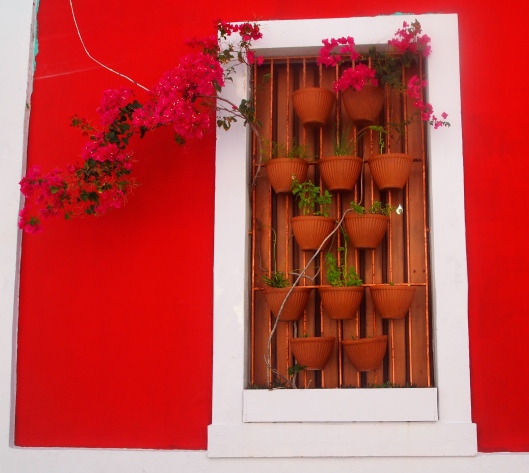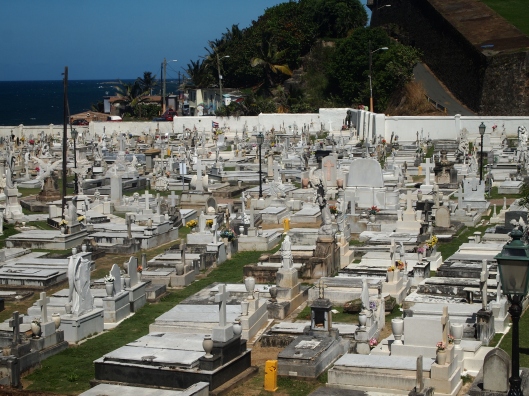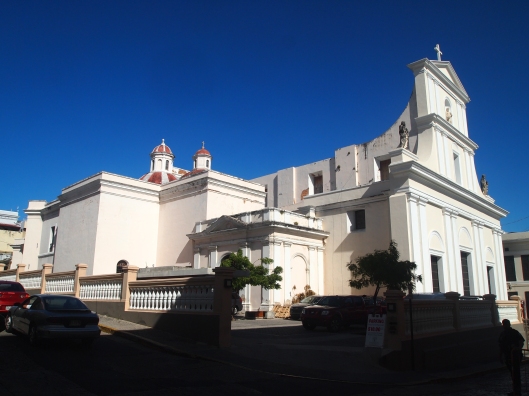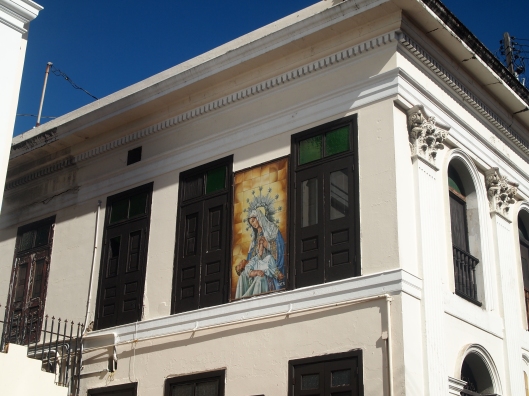Tags
El Morro, Ocean Park, Old San Juan, Puerto Rico, San Juan, Travel
Sunday, August 10: After lunch at The Parrot Club, we climb uphill in the searing sun to wander along the Norzagaray, which runs along the northern ridge overlooking the Atlantic. Looking down, we can see the faded pastel houses of La Perla, San Juan’s poorest neighborhood. It’s fun to wander the streets of Old San Juan with all its colorful and artsy buildings.
On the grounds of El Morro, which are quite extensive, families are out in droves, flying kites and picnicking. Below, we can see the picturesque Santa María Magdalena de Pazzis Cemetery, a colonial-era cemetery that is the final resting place of many of Puerto Rico’s most prominent natives and residents. Construction began in 1863 under the auspices of Ignacio Mascaro. It was named in honor of Saint Maria Magdalena de Pazzi. (Santa María Magdalena de Pazzis Cemetery)
We enter Fuerte San Felipe del Morro, better known as El Morro, a six-level fort with a gray, crenellated lighthouse. The fort juts over Old San Juan’s headlands, threatening wanna-be conquerors. The 140 ft. walls (some up to 15 ft. thick) date back to 1539, and El Morro is said to be the oldest Spanish fort in the New World. It was declared a UNESCO World Heritage site in 1983 (Lonely Planet Puerto Rico).
The National Park Service maintains this fort and its small military museum. It took nearly 200 years to build the fort, which played a role in rebuffing attacks by the British, the Dutch, and later, the U.S. military (Lonely Planet).
The lighthouse has been operating since 1846 (although the tower itself dates from 1906), making it the island’s oldest light station still in use today. The lighthouse was rebuilt with Spanish-Moorish features after suffering severe damage during a U.S. navy bombardment during the 1898 Spanish-American War (Lonely Planet).

Flagpoles on El Morro today customarily fly the United States flag, the Puerto Rican flag and the Cross of Burgundy Flag, also known in Spanish as las Aspas de Borgoña, a standard which was widely used by Spanish armies around the world from 1506–1785.
The School of Plastic Arts of Puerto Rico (Escuela de Artes Plásticas de Puerto Rico) is a higher learning institution engaged in the training of students in the visual arts. The school was originally founded in 1966 as part of the Institute of Puerto Rican Culture. (Wikipedia: School of Plastic Arts of Puerto Rico)
The building was built as an insane asylum during the 19th century, and with its symmetrical wings, columns, Romanesque arches, porticos, courtyards and fountains, it looks more like a seat of government than a school. Contemporary art students joke today about the mad dreams that continue to take shape within its walls (Lonely Planet).
At the Plaza del Quinto Centenario, we pass a 40-ft totem pole which is the work of Puerto Rican artist Jaime Suárez. It is made of black granite and ceramic pieces, and is a tribute to the discovery of the New World. The plaza was built in 1992 to commemorate the 500th anniversary of Christopher Columbus’ “discovery” of the New World. Rumored to have cost $10 million to build, the plaza offers great views over El Morro and the ocean.
San José Church (Iglesia de San José) is one of the first significant works of architecture on the island. The church is one of the earliest surviving examples of 16th-century Spanish Gothic architecture in the Western hemisphere. The church was constructed from 1532 to 1735 by the Dominican Order as part of their Saint Aquinas monastery. It was renamed by the Jesuits who took over the monastery in 1865. (Wikipedia: San José Church)
This church reminds me very much of churches I saw all over Portugal last year on my month-long trip through Spain and Portugal.
We end up walking again past the Catedral de San Juan as we make our way back downhill to the main commercial part of town.
We come across a shady outdoor cafe, Nadine Cafe, where an old violinist is serenading the patrons. A sign for Mojitos beckons. The old man leafs through a playbook that has seen better days, sighing dramatically between pieces. He seems to be tired of performing.
Once we sit down, we realize he is just a wandering violinist collecting money in a cup at his feet. He doesn’t seem to be actually employed by the cafe. The cafe atmosphere seems very relaxed. I take off my shoes because I’ve developed blisters on my heels, and I put them up on the empty wrought iron chair to air them out. We enjoy sipping on our icy Mojitos and listening to the music, that is, until the waitress comes over and tells me to take my feet off the chair. Ouch.
We find out when we get the bill that these Mojitos are $9 each! Yikes. In their defense, they did seem to be bottomless. I kept drinking and drinking mine and wondering why I never seemed to be making any progress.
Later, when I go inside to use the bathroom, I hear the waitress speaking loudly in Spanish to her coworkers about the “gringos” in an angry voice, and I hope she isn’t talking about us! I guess it was rude to put my feet on the chair, but it was outdoors and wrought-iron, so I didn’t think it would hurt anything!
After leaving Nadine’s, we return to SuperMax, where we buy some snacks and a bottle of Bacardi Rum. Our taxi driver drops us at Wind Chimes Boutique Hotel, the sister hotel to our Acacia Boutique Hotel, where we check out the swimming pool. The two hotels are less than a block apart, and while ours has the huge jacuzzi, the other has a small cool water swimming pool. As guests of Acacia, we’re able to use any of the facilities at Wind Chimes.
When we get to our room, Mike makes us some rum and cokes and we soak in the jacuzzi for a while.
It costs quite a lot to hire a taxi to go into Old San Juan from our hotel at Ocean Park (about $17-20 each way), so we decide tonight we will find a place to eat within walking distance. We decide on Basilia’s, which has zero in the way of ambiance, but is packed with Puerto Rican families. Atmosphere is seriously lacking. The walls are a blah white, there is no artwork, it’s brightly lit and it’s loud. But, we do have a tasty dinner. Mike orders Caribbean Salad with shredded pork, accompanied by a Magna beer, and I go for the delicious Mofongo (mashed green plantains) with roasted shredded pork, accompanied by a Medalla Light.
Needless to say, we’re exhausted by our walk today all over Old San Juan in the blistering heat, so we crash early. Tomorrow, we’re renting a car so we can visit El Yunque, the rain forest.




























Great post Cathy. From your lovely pictures San Juan looks like as vibrant and colorful as Cuba.
oh oh I’m sure a lot of us would also have put our feet up on the outdoor wrought iron furniture. Thanks for the warning!
Thanks so much, Rosie! I bet Cuba is more vibrant than San Juan, at least in my imagination. But San Juan was great. I needed that break for my feet, if only for a few minutes, before being chastised. 🙂
Such interesting photos, Cathy. The violinist was probably tired of playing the same tunes from that old book, day after day. 🙂 Sorry about your feet, but large Mojitos sounds like a great idea.
That poor violinist did seem to tired of the whole thing, Sylvia; he was quite old and has probably been doing this for a long time; maybe he’s too poor to retire. I felt bad for him. My feet were so blistered, I kept applying bandaids to my heels, but they wouldn’t stay on with all the moisture in the air and on my body! The Mojitos, though expensive, were just the ticket. 🙂